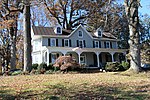Henryton Tunnel
American tunnel stubsBaltimore and Ohio Railroad tunnelsCSX Transportation tunnelsRailroad tunnels in MarylandTransportation buildings and structures in Carroll County, Maryland ... and 2 more
Tunnels completed in 1850United States rail transportation stubs

The Henryton Tunnel, located near Henryton in southern Carroll County, Maryland, is the third-oldest tunnel in the world that remains in active railroad use. Constructed by the Baltimore and Ohio (B&O) Railroad and opened around 1850, it was the first tunnel constructed on the B&O's Old Main Line. In 1865 the tunnel was widened to accommodate double track. It was rebuilt into its current form in 1903. The tunnel has brick portals and lining. The coping and footings are concrete.: 452
Excerpt from the Wikipedia article Henryton Tunnel (License: CC BY-SA 3.0, Authors, Images).Henryton Tunnel
Henryton Hospital Road,
Geographical coordinates (GPS) Address Nearby Places Show on map
Geographical coordinates (GPS)
| Latitude | Longitude |
|---|---|
| N 39.3512 ° | E -76.9128 ° |
Address
Henryton Hospital Road
Henryton Hospital Road
21104
Maryland, United States
Open on Google Maps





